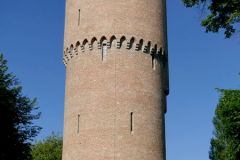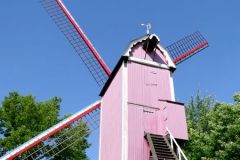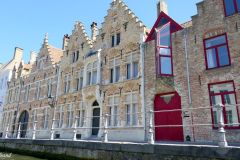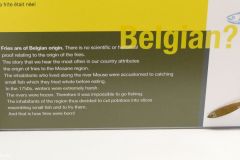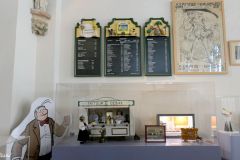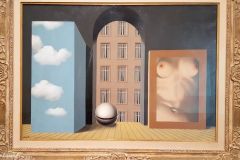This article will introduce you to points of interest, or sights, in the old city of Bruges, Belgium. A large selection has been plotted on the map presented at the bottom, while the text concentrates on the ultimate highlights – there are many.
It is a very pleasant city, full of history dating back to medieval times. Its inhabitants and authorities are taking care of their gem like few other historic cities in Europe. There is a lot to experience but one should also take time to relax and simply enjoy the atmosphere. I had high expectations and I was not let down.
World Heritage Sites
Among all sights in Bruges, the city offers no less than three UNESCO World Heritage Sites. In fact the entire city centre is one. In addition the belfry and the béguinage are part of ensembles of similar sites in Belgium, and neighbouring France and Netherlands respectively.
World Heritage #0996 – Historic Centre of Brugge: Brugge (or Bruges in English and French) is so charming, and so picture postcard perfect. There is so much to see, discover, learn and enjoy from walking along the canals, visiting the famous squares or just relax in a park.
World Heritage #0943 – Belfries of Belgium and France: This serial heritage site consists of 33 belfries scattered across both regions of Belgium and 23 in Northern France. Once you are in the right town finding the belfry is piece of cake really. Just look for the tallest old structure.
World Heritage #0855 – Flemish Béguinages: The white-coloured houses around a tranquil convent garden with high trees in the middle sends you mentally hundreds of years back in time, to the age of the béguines.
In addition, Bruges stages once a year the Procession of the Holy Blood, which is also a world heritage. More precisely it has been inscribed on “the other” UNESCO list, the List of the Intangible Cultural Heritage of Humanity. This is my article about it:
Procession of the Holy Blood: On Ascension Day each year more than 3,000 young and old inhabitants take to the streets to take part in a procession. On the “Most Beautiful Day of Bruges” 60-100,000 spectators watch them reenact the passion and resurrection of Jesus Christ as well as a number of other Biblical stories.
City gates and windmills
Start by circling the city centre before diving into it. The historic centre of Bruges has an egg-like shape and is surrounded by canals for most of the circle. Brugse Vesten (Bruges’ City Ramparts) are popular with the locals, among cyclists and runners, and also visitors who want to enjoy the green belt and the views. Several medieval city gates serve as landmarks on the way. One might want to start at Ezelpoort in the west and walk south to the railway station. Or one could take the eastern part like I did. The entire round trip is about 7 km, while my recommendation is 3 km one-way.
Start at the tall Powder Tower not far from the railway station and the Béguinage (Begijnhof). Have a look at the charming Minnewaterpark and continue on the paved and wide trail past the Water Tower to Gentpoort. Continue along the canal to Kruisvest, the ramparts where you can discover the four remaining windmills in the city: Bonne Chieremolen, Sint-Janshuis (still operational and with a museum inside), De Neuwe Papegaai and finally Koeleweimolen.
Canals (Reie)
Bruges is a medieval city with a defensive canal system around the centre. There are also a number of canals crisscrossing the interior. They were used for transportation in this city of merchants, but also served a military purpose. In any case, all these canals have earned Bruges the reputation of being “The Venice of the North”. You could join one of the ubiquitous river boats driving tourists around all day (and I recommend that you do). However, you should also venture out on your own, on foot. There is no real rush, you are bound to stumble upon a few of the reie during your stay.
These are among the most famous: Spiegelrei, Speelmansrei, Sint-Annarei, Langerei, Gouden Handrei, Augustijnenrei and Groenerei. The one you will almost certain pass by several times is the Dijver.
Museums
Not everyone is interested in museums when they visit a new city. I gave priority to visiting four of them. The Groeninge Museum is a highly acclaimed art museum. The Choco-Story and the Frietmuseum are fun and interesting museums. They are dedicated to the very special Belgian traditions of chocolate and pommes frites (not French! fries).
Museum Voor Volkskunde (Museum of Folk Life) was another great experience. I more or less stumbled upon it after my walk among the windmills. Housed in 17th century buildings it shows in various tableaux daily life in the 19th and early 20th centuries.
There are more museums, for instance the Picasso Exhibit, the Diamantmuseum, and the O.L.V.-ter-Potterie. Beer lovers might want to check out Bruges Beer Experience and De Gouden Boom Brewery, or just have a drink at the very popular Huisbrouwerij De Halve Maan.
Churches
There are many noteworthy churches scattered around the old part of Bruges and many of them have been marked on the map. There are two in particular I would like to point out, and you should try to get into.
The Holy Blood procession mentioned above stems from a medieval legend. The blood of the Jesus Christ is found on a piece of cloth kept inside the Basilica of the Holy Blood. The church in the corner of the square known as Burg is an almost divine beauty in its own right. You should definitely take time to see the shrine where the cloth is kept.
Onze-Lieve-Vrouwkerk (Church of Our Lady) with its very high tower (115.5 m) does not go unnoticed by anyone roaming the streets of Bruges. Building of the current church began in 1225. Several centuries went by to accomplish the structure we are able to admire now. There are a number of valuable pieces of art inside. The most famous is Michelangelo’s beautiful marble statue of Madonna and Child. Other highlights include the tombs of Mary of Burgundy and Charles the Bold. I was lucky to attend an evening concert in the church.
Buildings, squares, parks and more
Among the sights in Bruges, there are a number of fascinating squares around town. Some are charmingly small and obscure, others equipped with cafes for a coffee or more. The most important ones are the Market Square (Markt) and Burg. The former is the largest and is lined with charming residential buildings as well as monumental ones. The high Belfry fills one end of the square and the wide provincial court another.
Burg is just a stone’s throw off the Markt and has some particularly picturesque buildings. In addition to the mentioned Basilica of the Holy Blood there is the large Stadhuis, the charming little Oude Civiele Griffie and the Brugse Vrije.
Take note of these squares: Jan van Eyckplein at the end of the famous Spiegelrei has a relaxed atmosphere and some wonderful pieces of architecture surrounding it. Simon Stevinplein is picturesque and packed with tourists, and so is Walplein. Huidenvettersplein is also very charming. Boat tickets are purchased on either end of the square. It lies next to popular meeting points on the Rozenhoedkai and the Dijver park next to it, both situated on the bank of the Dijver rei.
There are two green lungs I would like to point out as particularly nice. One is the Minnewaterpark in the south, mentioned already. The other is the Koningin Astridpark.
One way or the other you will want to find your way across the very charming Bonifacius Bridge and also to the Sint-Janshospitaal – with a 800-years history in the service of public health, now a museum.
Sleep and eat
In the map coming up below you will find several restaurants. They are all tested and recommended. In addition you will want to look into one or two chocolatier shops and buy some exclusive pieces of tasteful art. Late at night I suggest you get a serving of really good frites (fries/chips) at a kiosk on Markt. They are the best I have ever tasted. Apart from this one should at least once try the traditional moules et frites, i.e. mussels and fries with a beer on the side.
I stayed at Die Swaene Hotel, perfectly sized, superb location, classy interior, very good breakfast and a delightful little swimming pool in the back. Check out the alternatives.
Map of 75 noteworthy sights in Bruges
Finally, here is the map I made prior to going on my three nights stay in Bruges, with additions while I was there and final adjustments afterwards. Pick your choice of sights in Bruges, use my text as a guide and see what you would like to do and see for yourself.
My visit to Bruges was blessed with lovely weather and a warming sun, which is not always the case here. I went on to Brussels for another couple of nights before leaving the country. Transportation between the cities and the airport was with trains, a very convenient choice in Belgium. Find out what more to discover in Belgium.
Due to all the cobbled stone streets connecting the sights of Bruges you will want to avoid dragging your suitcase with you and settle for a taxi to and from the railway station. Apart from this Bruges is made for walking, at least when it comes to its historic centre. So bring a pair of good walking shoes. Public transportation is more or less useless in the area covered by the map.
Check out the official Visit Bruges website and other Sandalsand articles from Belgium.










